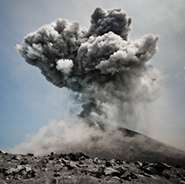Ocean cores reveal eruption dynamics

(Phys.org) —Using information gathered from samples of deep sea sediments, researchers from the University of Bristol report new findings regarding the dynamics of the eruption of Mount Tambora, Indonesia in 1815 – one of the largest volcanic eruptions in the last 1,000 years. Interpretation and understanding of such past eruptions are important for the assessment of hazards related to future eruptions.
During the 1815 Tambora eruption, the majority of erupted pyroclastic material was dispersed and subsequently deposited into the Indian Ocean and Java Sea. The research by Jessica Kandlbauer, a PhD student in Bristol's School of Earth Sciences, and colleagues focussed on the grain size distribution of the ash deposited in the deep sea compared to the ash fallen on land.
Large volcanic eruptions generate substantial plumes of gas and ash which rise in the atmosphere to a level of neutral buoyancy before spreading laterally as a gravity current, gradually depositing the ash component. Resulting deposits show a grain size distribution which fines away from source as the current cloud velocity, and so ability to carry particulates, decreases. Assessment of the grain size distribution of such volcanic deposits provides valuable information for the assessment of the environmental implications of an eruption, particularly in terms of human health and aviation safety.
Prior to this research, a full comparison between the land and sea records had not been undertaken as the highly turbulent oceanic environment and low-settling velocities of the ash had led to the opinion that the fine ash portion could not be fully preserved in these environments.
Jessica Kandlbauer said: "The most exciting finding of this study is the continuum from land to sea samples, with even the fine ash layers being preserved in the deep sea layers. This result further enhances the possibility of using the ocean record to investigate the history of other volcanic eruptions.
"Present gravity current eruption models only consider ash deposition during cloud advance, neglecting any ash remaining and depositing after the eruption ends. However we were only able to reconstruct the observed grain size distribution by including the ash component left in the umbrella cloud, once the eruption had stopped, into our gravity current model.
"Such interpretation and understanding of previous eruptions are vital for assessing the hazards of future eruptions. This study is another step forward in uncovering the details of our planet's volcanic history."
More information: Kandlbauer, J., Carey, S. and Sparks, S. The 1815 Tambora ash fall: Implications for transport and deposition of distal ash on land and in the deep sea, Bulletin of Volcanology. link.springer.com/article/10.1 … 07/s00445-013-0708-3
Provided by University of Bristol










.jpg)





